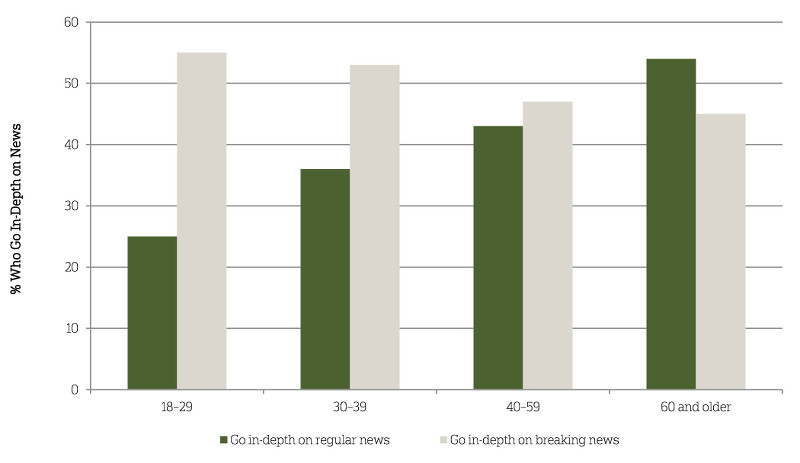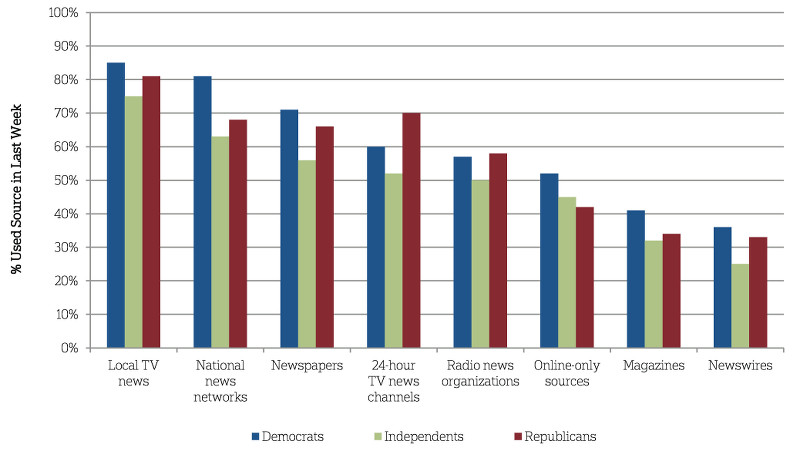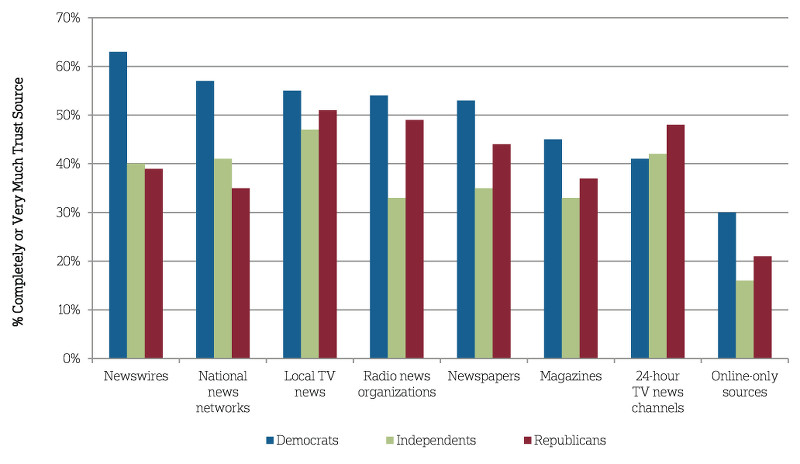Young people are active news consumers, with particular attentiveness to breaking news
The survey data provide a broad challenge to the notion that younger adults in the digital age are uninterested or are turning away from news about the world. Across a range of metrics—frequency, enjoyment, variety of topic interests, and more—younger adults are high news consumers. But there are some important differences by age.
Americans age 60 and over are somewhat more likely than the youngest adults, age 18-29, to say they enjoy keeping up with the news, although significant majorities of both groups do so (93 percent for those age 60 plus vs. 83 percent for those age 18-29). It follows then, that older Americans watch, read, or hear the news more often than the youngest cohort. Adults age 18-29 (59 percent) are significantly less likely than adults age 30-39 (75 percent), 40-59 (77 percent), and 60 and older (89 percent) to say they consume news at least once a day. But again, for majorities across all age groups, news consumption is a daily habit.
Older adults are also more likely to report reading, watching, or hearing a news story in-depth in the last week. Fully 54 percent of adults age 60 and over said they’d done so compared to just 1 in 4 young people 18-29, a third of adults 30-39, and 43 percent of those 40-59.
But while younger people may be slightly less attentive to news on a daily basis, they are more attentive to breaking news. Indeed, the youngest adults are more than twice as likely (55 percent) to follow up in-depth on breaking news as they are to report going in-depth in the last week on any news story (25 percent). Adults age 60 and over are less likely to report going in-depth on breaking news than on news generally.
Young people are attentive to a range of news topics at rates similar to older adults
Age does not impact people’s attentiveness to various news topics. Even the youngest adults are as likely to pay attention to news on topics such as business, politics, social issues, and foreign affairs as older adults. Further, they are no more likely than older adults to follow news on lifestyle topics.
Entertainment news is the only topic followed by a majority of younger people and a minority of older people. The only topic on which less than a majority of the youngest adults (49 percent) say they are likely to follow that a majority of older adults follow is schools and education. Even if one thinks that people are inclined to overstate their interest in some of these subjects, the difference in age groups, or the lack thereof, is revealing.

Question: Please tell me whether you personally try to keep up with news about each topic or not.
* Indicates a significant difference from the 18-29 age group.
The digital divide persists when it comes to news habits
While younger Americans are interested in a wide variety of topics at levels similar to older generations, the device they turn to and the way they discover the news is more clearly influenced by age.
Older adults are more likely to rely on television, radio, and print media for their news than are those in the youngest adult cohort, who are more likely to use mobile devices. However, more traditional devices are still important for younger adult news habits, too. Adults age 18-29 are equally as likely to get news from TV as from their cell phones. And there are distinct differences in the habits of those ages 18-29 from those who are age 30-39. For instance, adults 30-39 are as likely to utilize TV as their computers or their phones. The younger age cohort is less likely to use computers. Print publications are still used by nearly half of young adults 18-29 and just over half of adults 30-39 (47 percent and 55 percent, respectively).
Older generations are more likely to get news from television. Fully 89 percent of those age 40-59 and even more (95 percent) of those 60 plus used television to get news in the past week compared with younger adults age 18-29 (76 percent) and 30-39 (79 percent).
Radio is most popular among adults age 40-59; 74 percent say they used it to get news in the past week, significantly more than the 53 percent of 18-29 year olds, 59 percent of 30-39 year olds, and 64 percent of adults age 60 and over who say they used radio to get news in the past week.
All Americans get news in print in significant numbers each week, but there are differences by age. Three-quarters of adults age 60 and over say they read print publications in the past week versus 61 percent of adults age 40-59, 55 percent of adults age 30-39, and 47 percent of adults age 18-29.
The majority of Americans use computers (desktop and laptop) to get news. Seventy-three percent of adults age 18-29 got news this way in the past week compared with 82 percent of adults age 30-39 and 69 percent of adults age 40-59; meanwhile, 61 percent of adults age 60 and over say they did so.
Young adults are significantly more likely than older adults to say they used their cell phone to get news in the last week. Seventy-six percent of adults age 18-29 who own a cell phone and 84 percent of adults age 30-39 who own a cell phone say they used it to get news in the past week, while just 59 percent of adults age 40-59 and 37 percent of adults age 60 and over say they did so.
Among those who use tablets, no significant differences exist among age cohorts in the likelihood of people using those devices to read news; however, younger people are now more likely to own tablets in the first place. And of those who own or use a tablet, they are very likely to use them for news. Seventy-two percent of 18-29-year-old tablet owners used them to get news in the past week, about the same rate of use as 30-39 year olds (74 percent) and 40-59 year olds (75 percent), and a little higher than tablet owners who are 60 plus (65 percent).
Similarly, younger adults are more likely to find news through web-based media. Younger people age 18-29 are more than three times as likely to discover news through social media than adults 60 and older (71 percent vs. 21 percent). A majority of 30-39 year olds also discover news through social media (64 percent), as do 41 percent of 40-59 year olds. Similarly, people under 40 are more likely than those 40 and over to discover news through internet searches and online news aggregators.
Across all age groups, the preferred method for discovering the news is directly from a news organization; however, younger people are more likely to express a preference for social media as a means of discovery. Thirteen percent of 18-29 year olds cite social media as their preferred way to find news compared to 3 percent or less for all other age groups.
Levels of attention and enjoyment in following the news are consistent across racial and ethnic groups
Many of the broad findings discussed in this report hold true across racial and ethnic groups.
For example, interest in the news is equally high across ethnic groups, with 91 percent of non-Hispanic whites, 86 percent of African Americans, 87 percent of Hispanics, and 92 percent of people in other ethnicities reporting that they attend to the news several times a week or more. Similarly, levels of enjoyment in following the news are consistently high across racial and ethnic groups.
The Media Insight Project will be releasing additional analyses and new data about the personal news cycle of racial and ethnic groups in subsequent reports.
Partisans are more attentive to the news but differ in the types of news sources they rely on and trust
Partisans on both sides of the political spectrum differ from non-partisans in terms of their general news habits, as well as differing from each other when it comes to the types of news reporting sources they rely on and trust.
Democrats (81 percent) are more likely than both Republicans (68 percent) and independents (63 percent) to get news from national networks like NBC, CBS, or ABC. Republicans are instead more likely (70 percent) to go to 24-hour TV news channels like Fox News, CNN, or MSNBC, and they do so at significantly higher rates than Democrats (60 percent) or independents (52 percent).
Democrats, Republicans, and independents also show varying levels of trust for different news sources and methods of discovering news. Even when looking just at those who get their news from national news networks like NBC, CBS, and ABC, Democrats are more likely than independents to say they trust the information either very much or completely (57 percent vs. 35 percent). Democrats are also more trusting of newswires like the AP or Reuters than Republicans, with 63 percent of Democrats saying they trust it very much or completely. Less than 4 out of 10 (39 percent) Republicans express this level of trust.
Meanwhile, Democrats who watch 24-hour news networks are more skeptical than Republicans of the information these channels provide, with 16 percent saying they trust that information either slightly or not at all compared to just 9 percent of Republicans who feel the same. Overall, independents (31 percent) are less likely than Democrats (51 percent) to trust information they find from organizations who directly report the news like newspapers, TV newscasts, websites, or newswires generally.
Democrats also say that they enjoy following the news a lot or some at higher rates than independents (91 percent vs. 78 percent). They are also more likely to discover news through print newspapers or magazines (69 percent) than Republicans (59 percent) and independents (44 percent), and more likely to pay for news subscriptions (33 percent vs. 23 percent and 12 percent, respectively).
In addition, Democrats are more likely to follow in-depth news stories beyond just looking at headlines (47 percent vs. 39 percent and 30 percent, respectively), though there are no differences in likelihood to go in-depth on breaking news by party affiliation.
Men report a stronger interest in news, though women are more likely to discover news through social means and more likely to follow some topics
Men appear to have a slightly stronger interest in following the news than women. A greater share of men say that they enjoy keeping up with the news “a lot” (60 percent vs. 51 percent), while women are more likely to say they enjoy following the news “some” (37 percent vs. 27 percent). There are no differences between men and women in the percentage of people who don’t enjoy following the news. While men report slightly higher levels of enjoyment, they are no more likely than women to report reading, watching, or hearing an in-depth news piece in the last week or going in-depth on breaking news.
Women and men do differ in their attentiveness to different news topics. Women are more likely than men to report following news on schools and education (69 percent vs. 50 percent), health and medicine (74 percent vs. 56 percent), lifestyle topics (58 percent vs. 30 percent), and entertainment and celebrities (44 percent vs. 28 percent). Men are more likely to follow foreign or international news (75 percent vs. 61 percent) and sports news (57 percent vs. 34 percent).
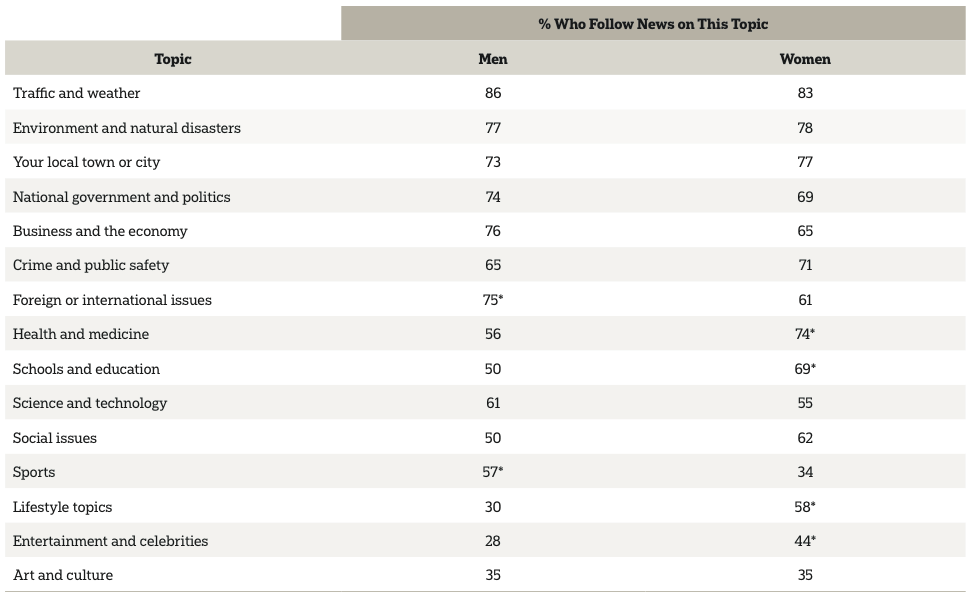
Question: Please tell me whether you personally try to keep up with news about each topic or not.
* Indicates a significant difference between men and women.
Women and men also consume news in slightly different ways.
Women are both more likely to discover news on social media (49 percent vs. 39 percent) and share news with friends through email, text message, or other online methods (50 percent vs. 41 percent). In general, women are more likely to say that they get news alerts by text, email, or app notification (51 percent vs. 43 percent), though they are no more likely than men to say they discovered news through electronic alerts in the last week specifically. Men, on the other hand, are more likely to turn to certain reporting sources, including news from a 24-hour TV news channel like Fox News, CNN, or MSNBC (68 percent vs. 56 percent) and radio news organizations (61 percent vs. 52 percent).

Women are more likely to discover news through social media and friends. Men are more likely to use aggregators and search engines.
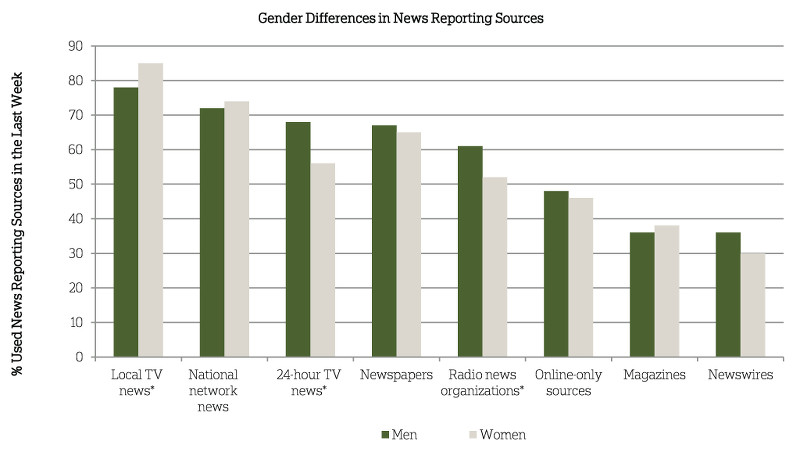
Men are much more likely to get news from 24-hour cable TV and from radio. Women are more likely to watch local TV news or network news broadcasts.
Men and women also differ in when they prefer to watch, read, or hear the news. Men are more likely to say they prefer to follow it throughout the day (38 percent vs. 28 percent) or last thing at night (11 percent vs. 7 percent). Women would rather follow it in the morning (28 percent vs. 21 percent) or in the evening (29 percent vs. 23 percent).
Income and education are associated with greater levels of news consumption and news-gathering habits
Though the differences are by no means dramatic, income is related to how Americans follow the news, how easy they feel it is to keep up with the news, and the sources they use for news. To the degree that was always true, it remains a factor in the digital age when news is more plentiful as well.
Americans with higher incomes are somewhat more likely to report watching, reading, or hearing the news on a daily basis or several times a week. Fully 98 percent of Americans with incomes greater than $100,000 per year report watching, reading, or hearing the news on a daily basis or several times per week, compared to 93 percent of Americans who have incomes between $50,000 and $100,000, and 87 percent of Americans who have incomes of less than $50,000.
Income is also related somewhat to the way Americans discover the news. Americans who have higher incomes are more likely to receive news from traditional news sources such as newspapers and radios. Americans with higher incomes are also more likely to discover news directly from a news organization that reports the news, such as a newspaper, TV newscast, website, or newswire. Fully 96 percent of Americans with incomes greater than $100,000 per year report receiving news from a news organization, compared to 88 percent of Americans with incomes under $100,000 per year. Similarly, 65 percent of Americans with incomes greater than $100,000 per year receive news from radio news organizations, compared to 61 percent of Americans with incomes between $50,000 and $100,000 per year, and 48 percent of Americans with incomes under $50,000 per year.
Americans with higher incomes are also more likely than those with lower incomes to receive news from online and other newer sources of news. Overall, 87 percent of Americans with incomes greater than $100,000 per year report receiving news through a computer, compared to 83 percent of Americans who have incomes between $50,000 and $100,000, and to 58 percent of Americans who have incomes of less than $50,000. Similarly, 68 percent of Americans with incomes greater than $100,000 per year received news from a search engine, compared to 58 percent of Americans with incomes between $50,000 and $100,000 per year, and 42 percent of Americans with incomes under $50,000 per year.
Americans with higher incomes are more likely to obtain news from online news organizations that mostly combine news from other sources. Sixty-five percent of Americans with incomes greater than $100,000 per year say they receive news from online news organizations that combine news from other sources, compared to 57 percent of Americans with incomes between $50,000 and $100,000 per year, and 45 percent of Americans with incomes under $50,000 per year.
Income levels also are related to trust in news sources. Americans with lower levels of income are more likely than others to report that they trust 24-hour TV news channels such as Fox News, CNN, or MSNBC “completely.” Just 6 percent of Americans with incomes greater than $100,000 per year trust 24-hour news channels “completely,” compared with 19 percent of Americans with incomes under $50,000 per year.
Finally, income is related to the likelihood of paying for news. Fully 39 percent of Americans with incomes greater than $100,000 per year reported having at least one paid subscription, compared with 28 percent of Americans with incomes between $50,000 and $100,000 per year, and 19 percent of Americans with incomes under $50,000 per year.
Even controlling for income levels, educational attainment is related to how Americans follow the news, how easy they feel it is to keep up with the news, and the sources they use for news. Americans with higher levels of education also are more likely to report watching, reading, or hearing the news on a daily basis or several times a week. Ninety-five percent of Americans who have completed college or graduate school reported watching, reading, or hearing the news on a daily basis or several times per week, compared to 88 percent of Americans who have completed high school or some college, and to 83 percent of Americans who have not completed high school.
Notably, Americans who have completed higher levels of education are more likely than those who have completed less education to report that they watched, read, or heard any in-depth stories in the past week. Fifty-seven percent of Americans who have completed college or graduate school reported that they watched, read, or heard an in-depth news story in the past week, compared to 36 percent of Americans who have completed high school or some college, and 20 percent of Americans who have not completed high school.
Educational attainment also is related to a key topic that Americans report following—news about the national government and politics. Fully 84 percent of Americans who have completed college or graduate school report that they keep up with news about the national government and politics, compared with 69 percent of Americans who have completed high school or some college, and 47 percent of Americans who have not completed high school.
Educational attainment also is related to the sources Americans use for news, with more highly educated Americans being more likely than those with lower levels of education to receive news from both traditional news sources such as newspapers and radios and online and emerging sources.
Americans with higher levels of education are more likely to report receiving news in the past week through newspaper content. Overall, 73 percent of Americans who have completed college or graduate school report receiving news from newspaper media, compared with 66 percent of Americans who have completed high school or some college, and 48 percent of Americans who have not completed high school.
Americans with higher levels of education are also more likely to report that they receive news from online or print magazines. In all, 46 percent of Americans who have completed college or graduate school report receiving news from magazines, compared to 35 percent of Americans who have completed high school or some college, and to 22 percent of Americans who have not completed high school.
Americans with higher levels of income and those with higher levels of education are more likely to report that they receive news from radio news organizations. Fully 65 percent of Americans who have completed college or graduate school report receiving news from radio news organizations, compared with 53 percent of Americans who have completed high school or some college, and 44 percent of Americans who have not completed high school.
Americans with higher levels of education are more likely to report that they receive news from newswires such as AP and Reuters. Overall, 44 percent of Americans who have completed college or graduate school report receiving news from newswires, compared to 30 percent of Americans who have completed high school or some college, and to 14 percent of Americans who have not completed high school.
In addition to influencing the sources used for keeping up with the news, education is related to the likelihood of paying for news. Overall, 36 percent of Americans who have completed college or graduate school report that they have at least one paid subscription, compared with 21 percent of Americans who have completed high school or some college, and 12 percent of Americans who have not completed high school.
Of those Americans who report having at least one paid subscription, those with higher levels of education are more likely to have paid subscriptions to a newspaper website, to a print magazine, and to a magazine website.
Fully 50 percent of Americans who have completed college or graduate school report that they had a paid subscription to a newspaper website, compared to 34 percent of Americans who have completed high school or some college. Fifty-five percent of Americans who have completed college or graduate school report that they have a paid subscription to a print magazine, compared to 33 percent of Americans who have completed high school or some college. Thirty-two percent of Americans who have completed college or graduate school reported that they have a paid subscription to a magazine website, compared to 13 percent of Americans who have completed high school or some college.
Share with your network
The personal news cycle
You also might be interested in:
As the American Press Institute marks 80 years, we’ll honor our legacy by continuing to respond to the evolving needs of news leaders. Our upcoming API Local News Summits will explore three critical places where democracy and sustainability intersect.
Reaching younger audiences has long been a challenge for media organizations. As platforms evolve, trust in news shifts and news avoidance grows, it can feel especially difficult to connect with and serve multigenerational audiences in an authentic and sustainable way. How can news leaders do their part to represent and include community perspectives from members of different age groups?
For us, we knew one of our biggest hurdles to success would be challenging the assumptions, both spoken and unspoken, we held for others. Here’s what we’ve learned over the past three years of gathering multigenerational problem-solvers.

